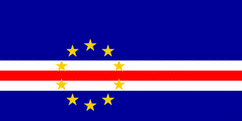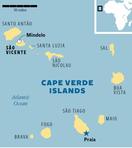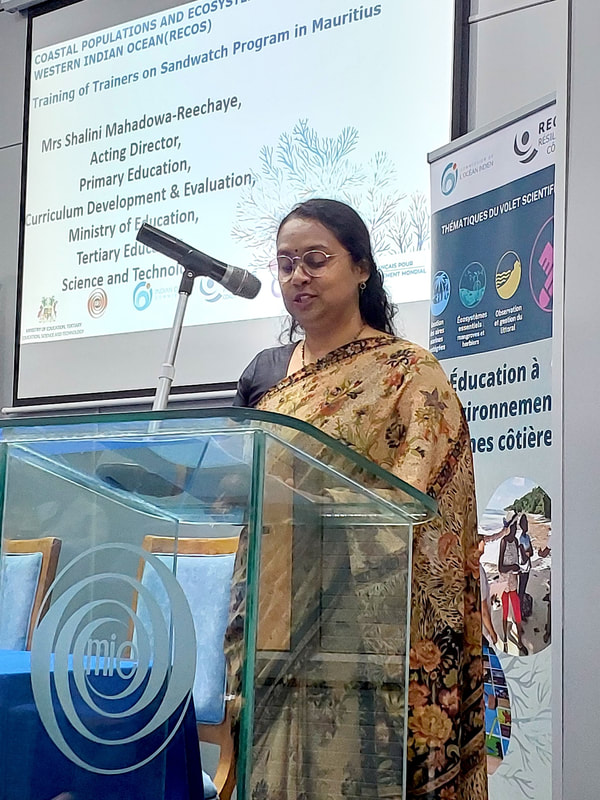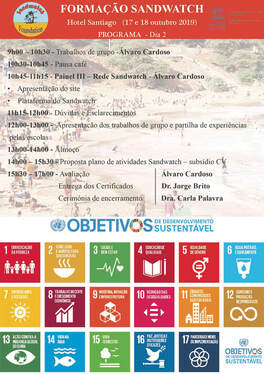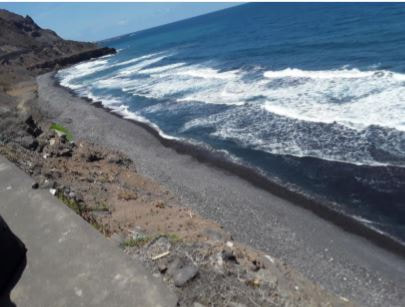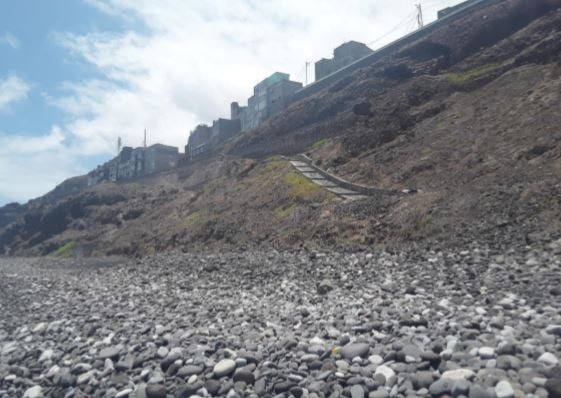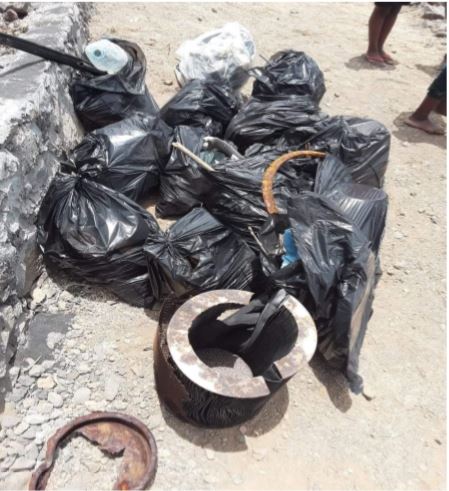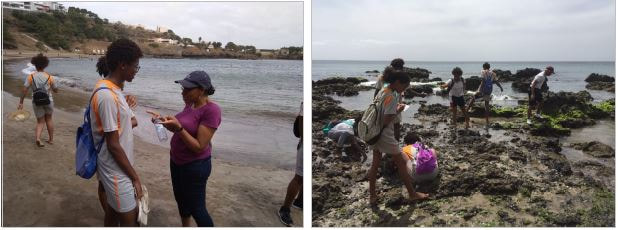Cape Verde Islands
Sandwatch activities started in: 2011
Coordination of Sandwatch in Cape Verde Islands:
Sandwatch in Cape Verde Islands is coordinated by the Cape Verde National Commission for UNESCO. Primary and secondary schools in Praia, Santiago and Boa Vista Islands are participating. A sub-regional Climate Change Education Workshop was held in Cape Verde in 2013.
Status of Sandwatch in Cape Verde Islands: Active
Activities and Highlights: Updates in progress
Salineiro Secondary School, Cape Verde Islands conducts Sandwatch
July 2021: This Sandwatch/UNESCO report was conducted in order to bring important information about the study visit carried out on Saturday, June 5th, to the Porto Mosquito bathing beach, located in Ribeira Grande de Santiago-Cidade Velha, UNESCO World Heritage Site in 2009. - Click here for full details!
Julho 2021: Este relatório enquadra-se no âmbito do projecto da UNESCO intitulado ‘’Sandwatch’’, a fim de trazer informações importantes sobre a visita de estudo realizada no dia 05 de Junho, Sábado, à praia balnear de Porto Mosquito, situada em Ribeira Grande de Santiago-Cidade Velha, Património Mundial da Humanidade pela UNESCO em 2009. - Clique aqui para mais detalhes!
July 2021: This Sandwatch/UNESCO report was conducted in order to bring important information about the study visit carried out on Saturday, June 5th, to the Porto Mosquito bathing beach, located in Ribeira Grande de Santiago-Cidade Velha, UNESCO World Heritage Site in 2009. - Click here for full details!
Julho 2021: Este relatório enquadra-se no âmbito do projecto da UNESCO intitulado ‘’Sandwatch’’, a fim de trazer informações importantes sobre a visita de estudo realizada no dia 05 de Junho, Sábado, à praia balnear de Porto Mosquito, situada em Ribeira Grande de Santiago-Cidade Velha, Património Mundial da Humanidade pela UNESCO em 2009. - Clique aqui para mais detalhes!
New Sandwatch Training Workshop to be Held in Cape Verde Islands
Oct 15-16th, 2019: The UNESCO National Commission of The Cape Verde Islands is pleased to announce that on October 15th-16th at the Hotel Santiago, they will be holding a Sandwatch Training Workshop (theoretical and practical) with teachers from around the region led Sandwatch trainer Dr. Álvaro Cardoso. This will increase the number of teacher with Sandwatch training around the country. - Click here for full details
Informamos que dia 15 e 16 de Outubro próximos, a Comissão Nacional da Unesco realizará uma Formacão Sandwatch, teórico-prática. O Formador é o Sandwatcher Dr. Álvaro Cardoso que ministrará professores que ainda não tiveram esta formacão. Segue o programa com mais pormenores.
Oct 15-16th, 2019: The UNESCO National Commission of The Cape Verde Islands is pleased to announce that on October 15th-16th at the Hotel Santiago, they will be holding a Sandwatch Training Workshop (theoretical and practical) with teachers from around the region led Sandwatch trainer Dr. Álvaro Cardoso. This will increase the number of teacher with Sandwatch training around the country. - Click here for full details
Informamos que dia 15 e 16 de Outubro próximos, a Comissão Nacional da Unesco realizará uma Formacão Sandwatch, teórico-prática. O Formador é o Sandwatcher Dr. Álvaro Cardoso que ministrará professores que ainda não tiveram esta formacão. Segue o programa com mais pormenores.
|
Cape Verde Islands Sandwathers 2019 Report
We conducted two Sandwatch field trips on May 4 and June 14, both at 11:30 am at the “Praia Pequena”, located in Ribeira Grande de Santo Antão. These visits were attended by a group of students from Suzete Delgado Secondary School, accompanied by teachers, under the guidance of the school's management, in the person of its Director Mr. Jorge Delgado. With these trips we wanted to achieve the following objectives: - Inform about the Sandwatch Program, its origin, objectives, methodology and necessary work equipment. - Justify why we chose “Little Beach” for our beach monitoring pilot without you. - Make known the work or activity developed within the Sandwatch Program. - Report the state of the beach as part of the first observation activity. - Suggest a set of interventions to make the beach more attractive to swimmers, tourists and beach goers. - Please click here to see our homepages and here to see our full report and some photos from our trips are below |
The Abílio Duarte Secondary School on Cape Verde Conducts Three Sandwatch Field Trips
Over January, February and March 2019 Sandwatchers from Abílio Duarte Secondary School conducted three separate field trips to Quebra Canela Beach in the city of Praia, Cape Verde Islands. The purpose of the trips was to expose 7th & 12th year students to Sandwatch’s M.A.S.T. Methodology of Monitoring the environment, Analyzing results, Share findings and Take Action.
- Please click here to d/l and view our original reports in Portuguese 1st Trip, 2nd Trip, 3rd Trip
1. On January 25, 2019, at 3 p.m., at Abílio Duarte Secondary School, a workshop related to the Sandwatch project took place, under the supervision of The Ministry of Education in Praia. It was intended for pupils of the 7th and 12th school year and had as its objective the presentation of he Sandwatch concept, its purpose and its methodology. This workshop was also aimed at creating a new group of Sandwatchers who would adopt Quebra Canela beach as their project. Thirty-seven (37) students and the school’s deputy director participated in the training, under the guidance of the project coordinator, Ms. Baessa Geisa. From this meeting, it was agreed that the first activity on Quebra Canela beach would be to observe and record information relating to activities on the beach.
- Please click here to d/l and view our original reports in Portuguese 1st Trip, 2nd Trip, 3rd Trip
1. On January 25, 2019, at 3 p.m., at Abílio Duarte Secondary School, a workshop related to the Sandwatch project took place, under the supervision of The Ministry of Education in Praia. It was intended for pupils of the 7th and 12th school year and had as its objective the presentation of he Sandwatch concept, its purpose and its methodology. This workshop was also aimed at creating a new group of Sandwatchers who would adopt Quebra Canela beach as their project. Thirty-seven (37) students and the school’s deputy director participated in the training, under the guidance of the project coordinator, Ms. Baessa Geisa. From this meeting, it was agreed that the first activity on Quebra Canela beach would be to observe and record information relating to activities on the beach.
2. On February 16, 2019, a visit was made to Quebra Canela beach with the following objectives: observing, recording information relating to the beach, taking stock of existing problems and thinking of how to solve them.
Twenty-two (22) students from grades 7 to 12, as well as six (6) teachers of different subjects (Portuguese, biology, natural sciences, sociology, civics and mathematics) participated in this activity.
The students took photos and made a sketch of the beach.
From this meeting, it was agreed that the next step would be the analysis of the water quality and the development of a questionnaire directed to the public that use the beach.
3. On March 4, 2019, we held the third Sandwatch activity, on the beach in Quebra Canela. Seventeen (17) students and four teachers (4) participated. The questionnaire, developed by the students, was given to thirty (30) people on the beach. The purpose of this questionnaire was to know the profile of people who go to the beach, to know their perceptions regarding the problems and the impact of climate change on the beach. Then, under the guidance of the project coordinator, the water quality was analyzed and the range was measured. Parameters such as PH, nitrates, phosphates and fecal coliforms were used for the analysis of water quality. A tape measure was used to measure the beach.
Sandwatchers launch environmental campaign in Cape Verde
As Coordinator of this Sandwatch Project for the Salineiro Secondary School, I check every activity we do on the beaches we have visited, because we are increasingly aware that protecting and preserving the environment is an important contribution to the balance of the ecosystem and our health. We need guidance in this country on environmental education, because if we continue on this path, we will be increasingly exposed to the perils of unstable Nature. One of the most practical things we can today is work on Sandwatch using its methodologies and teach these things to our students. Using Sandwatch research we will suggest a set of measures that may be needed to solve the problems of Praia do Caniço and make it more resilient, beautiful and attractive. The following are some of the things we doing to achieve these goals based upon Sandwatch practices.
• An urgent cleaning campaign for the removal of all trash that is on the perimeter of the beach. We are doing this with the contribution of the Municipality of Ribeira Grande de Santiago (Sanitation, Tourism and Culture Pelouros), the Salineiro Secondary School (and it’s Sandwatch team) and the Health Office of RGS.
• Sensitization of bathers who go to the beach to avoid littering on the beach. By informing them of the many consequences it can have on the environment and public health.
• Construction of a gate that prevents the run off floods from heavy rains reaching the beach with a high intensity thus avoiding the garbage that is dragged to the seafront.
• Protection of slopes via planting trees and shrubs to prevent landslides of dirt ad stones to fall onto the sand.
• Planting of trees and improvements of the trees/vegetation that exist in and around the beaches with the intention of giving more attractiveness and shade to the beach areas
• Increase the number of containers for garbage on the beach for bathers, where the sanitation services of the local authority can collect them regularly, thus avoiding the accumulation of garbage.
• Avoid leaving scraps of fish, other foodstuff and trash on the ground and make stakeholders aware of the proper use of the containers.
• Beach safety should also be enhanced as our beach is fairly isolated; it would be desirable if possible to have lifeguards and a look-out post so that swimmers can feel safer.
As Coordinator of this Sandwatch Project for the Salineiro Secondary School, I check every activity we do on the beaches we have visited, because we are increasingly aware that protecting and preserving the environment is an important contribution to the balance of the ecosystem and our health. We need guidance in this country on environmental education, because if we continue on this path, we will be increasingly exposed to the perils of unstable Nature. One of the most practical things we can today is work on Sandwatch using its methodologies and teach these things to our students. Using Sandwatch research we will suggest a set of measures that may be needed to solve the problems of Praia do Caniço and make it more resilient, beautiful and attractive. The following are some of the things we doing to achieve these goals based upon Sandwatch practices.
• An urgent cleaning campaign for the removal of all trash that is on the perimeter of the beach. We are doing this with the contribution of the Municipality of Ribeira Grande de Santiago (Sanitation, Tourism and Culture Pelouros), the Salineiro Secondary School (and it’s Sandwatch team) and the Health Office of RGS.
• Sensitization of bathers who go to the beach to avoid littering on the beach. By informing them of the many consequences it can have on the environment and public health.
• Construction of a gate that prevents the run off floods from heavy rains reaching the beach with a high intensity thus avoiding the garbage that is dragged to the seafront.
• Protection of slopes via planting trees and shrubs to prevent landslides of dirt ad stones to fall onto the sand.
• Planting of trees and improvements of the trees/vegetation that exist in and around the beaches with the intention of giving more attractiveness and shade to the beach areas
• Increase the number of containers for garbage on the beach for bathers, where the sanitation services of the local authority can collect them regularly, thus avoiding the accumulation of garbage.
• Avoid leaving scraps of fish, other foodstuff and trash on the ground and make stakeholders aware of the proper use of the containers.
• Beach safety should also be enhanced as our beach is fairly isolated; it would be desirable if possible to have lifeguards and a look-out post so that swimmers can feel safer.
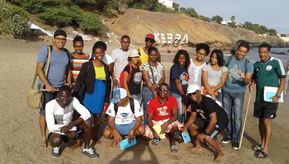
Sandwatch teacher training held on Cape Verde
For the school year 2016-2017, the National Commission for UNESCO Cabo Verde and Sandwatchers Schools held new teacher training on February 23th-24th, to build capacity and augment the number of teachers involved in Sandwatch in the Cape Verde Islands. Altogether 19 school teachers received instructions from local Sandwatch trainers José Maria Pires, Geisa Baessa and Alvaro Cardoso, both in class and on Kebra Kanela beach.
- Please click here for details
For the school year 2016-2017, the National Commission for UNESCO Cabo Verde and Sandwatchers Schools held new teacher training on February 23th-24th, to build capacity and augment the number of teachers involved in Sandwatch in the Cape Verde Islands. Altogether 19 school teachers received instructions from local Sandwatch trainers José Maria Pires, Geisa Baessa and Alvaro Cardoso, both in class and on Kebra Kanela beach.
- Please click here for details
